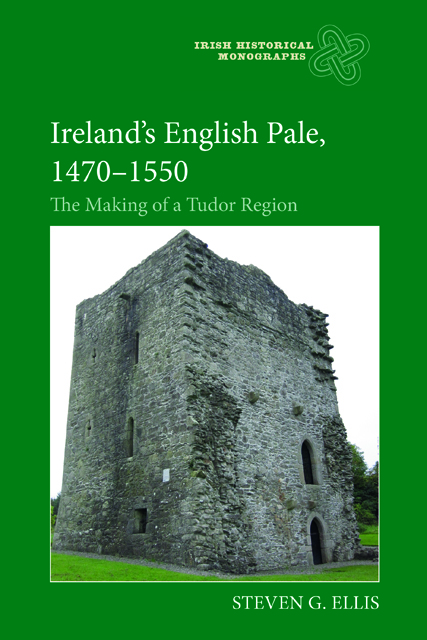Book contents
- Frontmatter
- Contents
- List of Maps
- Preface
- List of Abbreviations
- Introduction: in search of Ireland's English Pale
- 1 The horizons of English rule: retreat and recovery
- 2 The fortifications and identity of a military frontier
- 3 County Dublin and the military frontier
- 4 Strengthening the march in County Kildare
- 5 The English Pale's westward expansion: County Meath
- 6 The English Pale's northern frontier: County Louth
- 7 Restoring the English Pale, 1534-41
- 8 The waning of the English Pale
- Conclusion: an English region in Tudor Ireland
- Bibliography
- Index
- Irish Historical Monographs previous volumes
8 - The waning of the English Pale
Published online by Cambridge University Press: 09 January 2024
- Frontmatter
- Contents
- List of Maps
- Preface
- List of Abbreviations
- Introduction: in search of Ireland's English Pale
- 1 The horizons of English rule: retreat and recovery
- 2 The fortifications and identity of a military frontier
- 3 County Dublin and the military frontier
- 4 Strengthening the march in County Kildare
- 5 The English Pale's westward expansion: County Meath
- 6 The English Pale's northern frontier: County Louth
- 7 Restoring the English Pale, 1534-41
- 8 The waning of the English Pale
- Conclusion: an English region in Tudor Ireland
- Bibliography
- Index
- Irish Historical Monographs previous volumes
Summary
Since at least 1470, the established policy of successive kings to maintain English rule in Ireland had followed two key aims, usually met by focusing on the English Pale. The first was to ensure that English Ireland was governed out of the lordship’s internal resources, so that the government of Ireland did not become a charge on the king’s English revenues but remained financially self-sufficient. The second was to ensure that the burden of defending the English parts rested on the king’s subjects there, without the need for an expensive army out of England. On the whole, the creation of the English Pale had largely secured these aims; but from 1541 Tudor policy departed quite radically from these traditional objectives. The English Pale soon lost much of its strategic importance as the government embarked instead on a policy of incorporating the Irish lordships by consent into a new, Tudor kingdom of Ireland involving a wholesale anglicization of the country. Then, from 1547, Tudor policy veered back towards the defence and expansion of a revived English Pale which, in the extended afterlife it now enjoyed, became heavily dependent on financial and military subventions from England.
In summer 1540, Lord Leonard Grey’s replacement as governor was the former royal commissioner, Sir Anthony St Leger, who was less of a military captain than an administrator. As commissioner in 1537–8, St Leger had seen the difficulties in securing the Pale against attacks by border chiefs like O’Connor Faly. He had observed the successful military campaigning in Offaly by which Lord Deputy Grey had eventually secured the chief’s submission. He also reported perceptively to Cromwell on Grey’s campaign:
the same countre is moche easlyer wonne then kept, for whensoever the Kyngis pleasure be to wynne the same again, it wilbe don without great difficultie, but the keping thereof wilbe bothe chargeable and difficyll.
St Leger’s further comment to Cromwell also demonstrated his appreciation of the earlier strategy for extending the English Pale by which Kildare had recovered marchlands from border chiefs, erected towerhouses for defence, and imported agricultural tenants to promote tillage: ‘onelesse [the country] be peopled with others then be there alredy, and also certen fortresses there buylded and warded, if it be gotten the one daye, it is loste the next.’
- Type
- Chapter
- Information
- Ireland's English Pale, 1470-1550The Making of a Tudor Region, pp. 155 - 168Publisher: Boydell & BrewerPrint publication year: 2021



